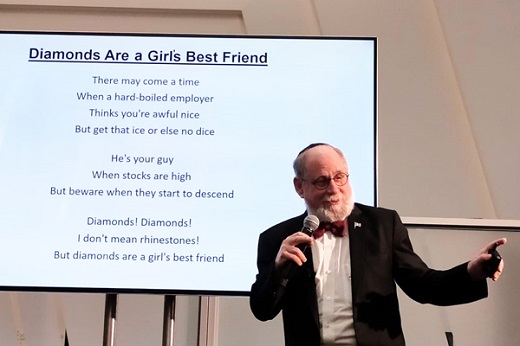
RAPAPORT... In 2100,
the diamond industry will look vastly different from its current makeup, Martin
Rapaport assured diamantaires at the recent Antwerp Rough Diamond Days event. Most
notably, it will be less influenced by the mining companies as demand dynamics
increasingly impact the market, the chairman of the Rapaport Group noted.“Market
power is shifting from supply to demand,” Rapaport explained at the November 21
event, which coincided with the Antwerpsche Diamantkring bourse’s 90th
anniversary. “In the next 90 years, diamond-mining companies will not have
market power. They probably won’t even exist, as diamond mining will be very
limited.”
When
rough supplies are reduced, and eventually eliminated from the open market,
recycled diamonds, gems and jewelry will emerge as the primary source of
supply, with elderly consumers selling and young ones buying. That will result
in a more profitable diamond and jewelry trade, as “unconstrained free-market
supply becomes available from motivated sellers,” Rapaport continued.
Gift
of commitment
Meanwhile,
on the demand side, growth will be driven by demographics as the global
population is projected to rise by 40% to 10.9 billion people by 2100, and
middle-income earnings will rise by 24% to $7.08 trillion, according to United
Nations forecasts Rapaport cited.
With
those predictions in mind, the challenge for the diamond industry is to ensure
that diamonds remain a symbolic gift of commitment. “The gift of a diamond
engagement ring is a social contract and the idea of a social contract at a
time of commitment is a cultural requirement that transcends generations,” he
explained. “It will be as relevant in 2100 as it is today.”
Ensuring
the continuation of diamond demand into the next century requires maintaining
an honest and liquid diamond market that provides fair value to buyers and
sellers.
Riches
in the niches
The
long-term viability of the diamond trade, particularly for dealers, was an
issue he emphasized in a presentation at the New York Diamond Dealers Club the
previous week. Rapaport recognized the turmoil the diamond industry currently
faces, as profits and liquidity are disappearing.
Midstream
profit margins are being squeezed by the mining sector, which can only improve
its profit by raising rough prices, while manufacturers keep buying the rough
so they can keep getting credit, he noted.
At the
same time, consumer demand has narrowed, in part due to a shift toward branding
and a lack of generic marketing over the past decade or two. Instead of trying
to sell diamonds to everybody, companies have decided to sell diamonds in areas
where you can make the most money, which is by having a brand.
As
dealers are in the generic business, they need to create a niche that
differentiates them — whether in a certain cut of
diamonds, or goods with strong blue fluorescence, for example. “The riches are
in the niches,” he stressed.
Finding
a niche is not so easy considering the midstream is being further squeezed by
“disintermediation” — the phenomenon in which suppliers
cut out the middleman by selling directly to the consumer. It’s worse than that,
since everybody’s supplier’s supplier is trying to sell the customer’s customer,
Rapaport continued. “De Beers is opening up jewelry shops and Tiffany is
cutting diamonds,” he noted.
A critical
mass
Despite
this trend, Rapaport stressed that dealers still added value to the
distribution chain. “Brands are selective, but they still need goods,” he emphasized
in New York. “There’s no way a retailer can keep an inventory of all the items
that are necessary and so dealers become the retailer’s lifeblood.”
As such,
Rapaport outlined an opportunity for the New York trade to make money: Becoming
a very efficient source of memo goods for the US market. The key role of
diamond dealers is to move the entire range of diamond types and quality down
the pipeline: “That’s how dealers make money. They find the right diamond, for
the right person, at the right location, at the right time, and at the right
price,” he added.
Similarly,
diamond manufacturers need dealers as a source of liquidity, because if dealers
don’t buy their polished, cutters might lose their credit lines, and therefore
their ability — or contract — to buy rough.
“Don’t
underestimate the power of the dealers, or our power as a group of committed
people working together in an industry,” Rapaport concluded at his New York
presentation. “We have a critical mass. There is added value coming from the simple
fact that we’re all together.”
Maintaining
that vibrant trade will be crucial for the future of the diamond market over
the next 90 years, he added in Antwerp. “The ability of diamonds to retain
value is in the hands of the diamond trade,” Rapaport stressed. “It is the responsibility
of the diamond trade to ensure liquid, fair markets for natural diamonds.”
Image: Martin Rapaport, chairman of the Rapaport Group, delivers a presentation on the future of the diamond industry in Antwerp last week. (Rapaport News)
|